Exploring roads less travelled in the cooler parts of Australia and New Zealand
Home Articles Places Categories Videos Maps About Sitemap

The Bibbulmun Track is one of Australia's great hikes, a magnificent bush trail stretching 963km through the south western corner of WA. I haven't walked it all and am certainly no expert, but over the years I've covered much of it in shorter sections. Dragging a heavy pack long distances over hills and through forests has been a learning experience; here are five things the Bibbulmun has taught me.
Not many attempt the Bibbulmun Track in the hot dry summer months, which is not surprising. But what I do find surprising is how many love the warm and crowded spring season and yet shun winter, dismissing it as too cold.
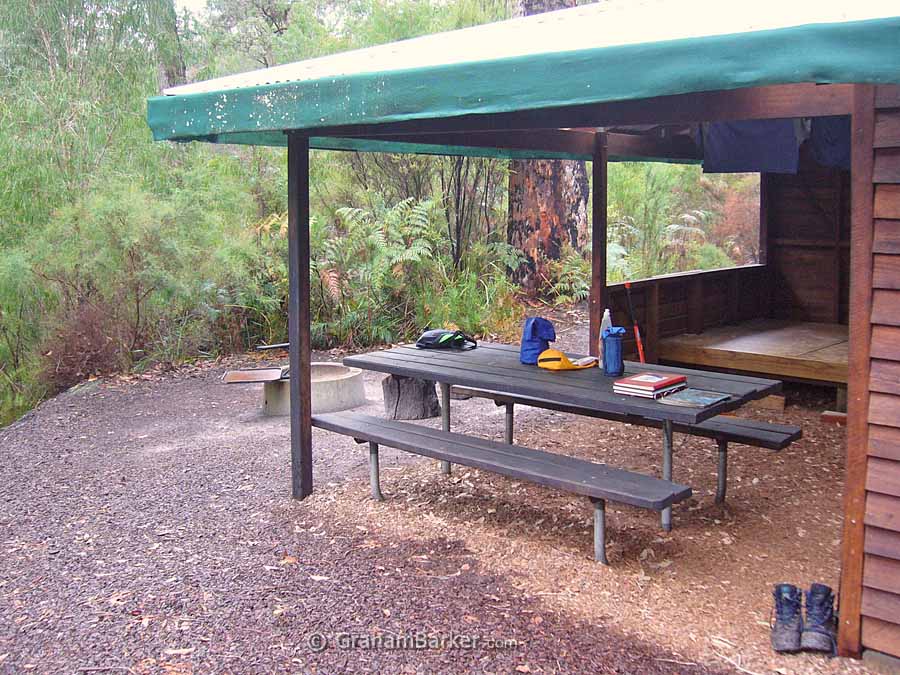
Peace and quiet with space to spread out: Gardner shelter in winter
I have ventured out in spring, but have come to prefer winter as the best time to hike the Bibbulmun Track because:
Winter is the rainy season on the Bibbulmun Track. By choosing winter to go hiking I needed good protection from rain, and so I followed the lead of others and took the trusty old goretex jacket and pants that had served me so well in the snow.
Goretex (and the many waterproof and breathable equivalents) is great for alpine conditions, or wet weather when it is seriously cold. But daytime hiking in south west WA is usually neither of these. Even in the wintriest WA weather there aren't many days in the year when it fails to reach 13 degrees on the Bibbulmun Track; more often you'll be hiking in 15 to 20 degrees during the daytime. And if it is raining, there will be humidity.
Others with different metabolisms may disagree, but my experience of Bibbulmun hiking in a goretex jacket, up and down hills carrying a heavy load, was one of overheating and much sweatiness. I think I got as wet from the sweat inside the jacket as I would have done from the rain outside it. And rain doesn't smell as bad!
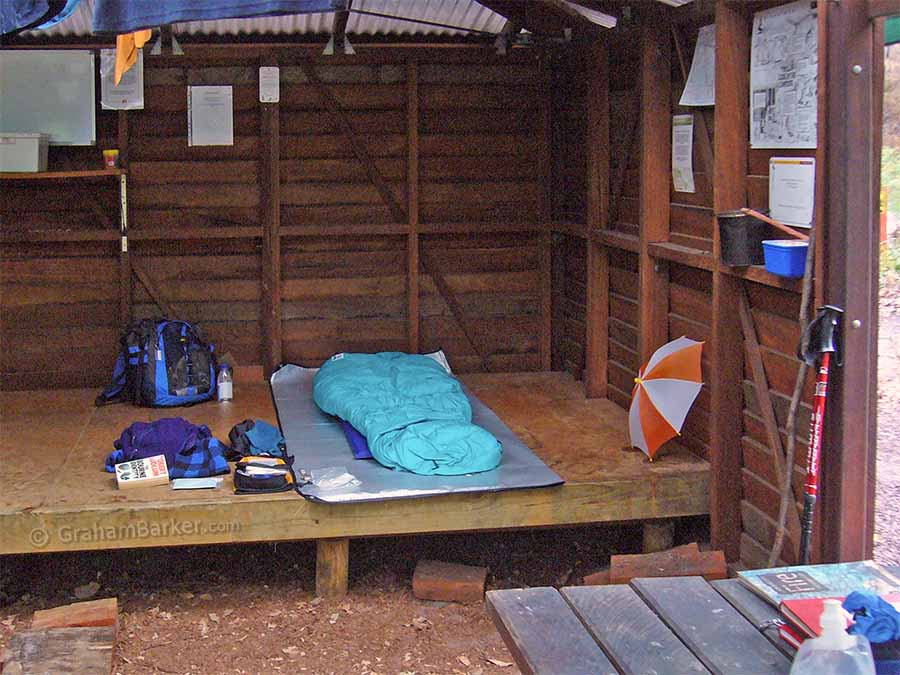
Umbrella hat drying inside a track shelter
Keeping dry is important, but I found wearing a cape to be more effective in the relative mildness of WA. A large cape protects well from rain and can also double as a pack cover. The openness allows some air to circulate underneath, reducing sweat and overheating.
For rain which is too wet for a hat, I wear an umbrella hat if it isn't too windy. Yes, it looks a bit dorky, but a small umbrella strapped onto the head complements a cape very well. It keeps rain from soaking down the neck, while keeping both hands free and providing much more air circulation over the head than any hood or hat.
As part of the endless quest to reduce weight I considered hiding food packages in the bush along the route. This works well on polar expeditions, but I was concerned about relying on it here with our mild climate, wildlife, and public access to the track. Would animals or humans steal the food that I would be depending upon? I tried it to find out.
The Bibbulmun Track regularly crosses minor roads or gravel tracks which are accessible to a conventional car. Shortly before a couple of four or five day walks I drove close to access points near the mid-points of the walks and hid food in the bush.
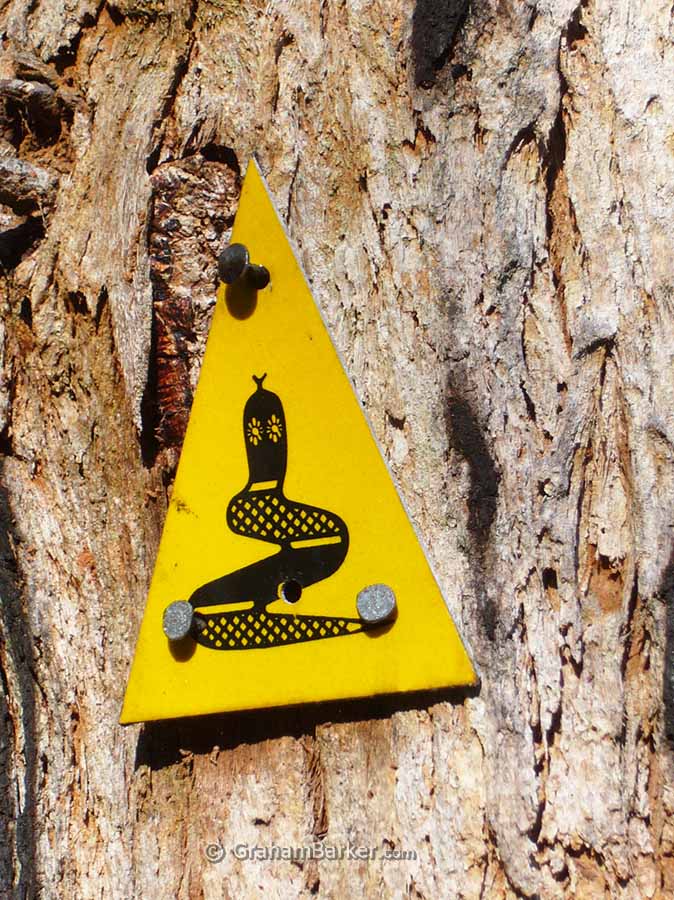
Waugal trail marker
It worked - I set off with only half the food and fuel needed, and collected the rest from the stashes I had hidden. This not only reduced the load I started out with, but also provided the opportunity for some luxuries. Like a carton of vegetable juice - not the sort of thing I'd hike far with due to the weight, but a very welcome find when retrieved from a food drop.
To guard against hungry animals I only used food and drink sealed in cartons or original packaging, to eliminate any scent. I also wrapped it in waterproof plastic, then stored in a tough stuff-sack. For protection from curious humans I hid the bags well away from the track, and made sure I memorised the location. So far I've had no problem finding my food bags undisturbed.
The maps and guides to the Bibbulmun Track come with track profiles - diagrams showing the changes in elevation on each day's walk. In theory this is useful; it gives you an idea of how much climbing and descending is in each section, and how big or steep the ups and downs are.
In reality, the usefulness is limited by the small scale of the diagrams. They give no indication of the rises and falls which are too small to show, and which are abundant on some parts of the Bibbulmun. And these little ups and downs can feel like mountains when accumulated over a long day.
Take these two examples of track through the karri forests north of Pemberton. The first, from Boarding House campsite South to Beavis, has some obvious steep climbs and descents as the track passes over ridges and across valleys. On the whole, the diagram gives a good indication of what to expect. The hills knackered me, but it wasn't so bad because I was mentally prepared and was able to plan for them.
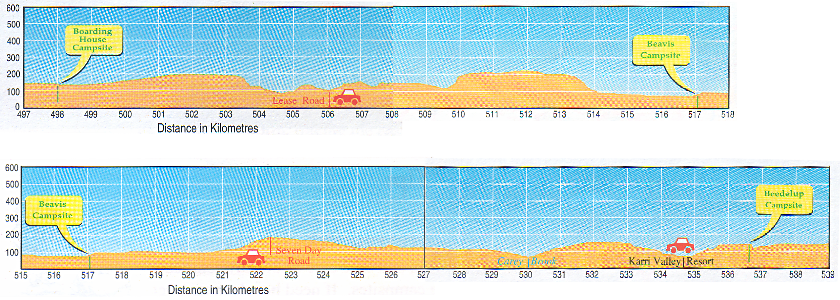
Profile diagrams of two track sections: Boarding House to Beavis (top), and Beavis to Beedelup
The next day, from Beavis to Beedelup, looked a little easier according to the profile. But it wasn't. Soon after leaving the campsite the track went steeply upwards for about 50 metres. Then around a curve, and straight back down 50 metres to the same level. This proved to be the template for the day - up a few metres, down a few, up a few, down a few more ... without any apparent need or purpose. Flat bits were the exception.
By the end of the day the ups and downs added up to a mountain, or at least that's how it felt. Yet apart from two gentle climbs over broad ridges the profile looked mostly like an easy stroll in a flat park - because the scale is too small to show the reality in detail.
In other words, take the profile diagrams with a pinch of salt. If it looks steep and hilly, it is. If it looks flat, it might be ... but it might not be.
Many people are enticed by the challenge of a long journey. Their satisfaction is gained from the sense of progress, the passing of milestones, and the feeling of achievement when reaching a distant goal.
Others, however, believe the journey itself is more important than the destination, or even getting to the destination. This has become such a well quoted idea it is almost a cliche - which suggests there might be some truth in it.
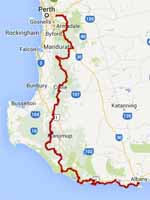
The Bibbulmun Track first captured my imagination as a challenge: that of getting from A to B, or in this case, walking the 963 km from Perth to Albany. Covering the distance was my lofty goal, and the scenery simply made it more enjoyable.
Then one morning I remember sitting in a campsite shelter reading other hikers' comments in the log book. It's not unusual to read boastful accounts of "double-hutting" - reaching a campsite early enough in the day to continue on and reach the next one, doing two days' walk in one. At first I was impressed by the fitness of these fast hikers, but the more I thought about it, the more I wondered ... why? What is the point?
I had come to realise that what I enjoyed most was not ticking off sections from a map, but simply "being there". Being immersed in the beauty of the WA bush, and travelling slowly enough to smell the roses. Or in this case some of the most prolific and unique wildflowers on the planet. And the wildlife is pretty neat too, if you sit still long enough to observe it.
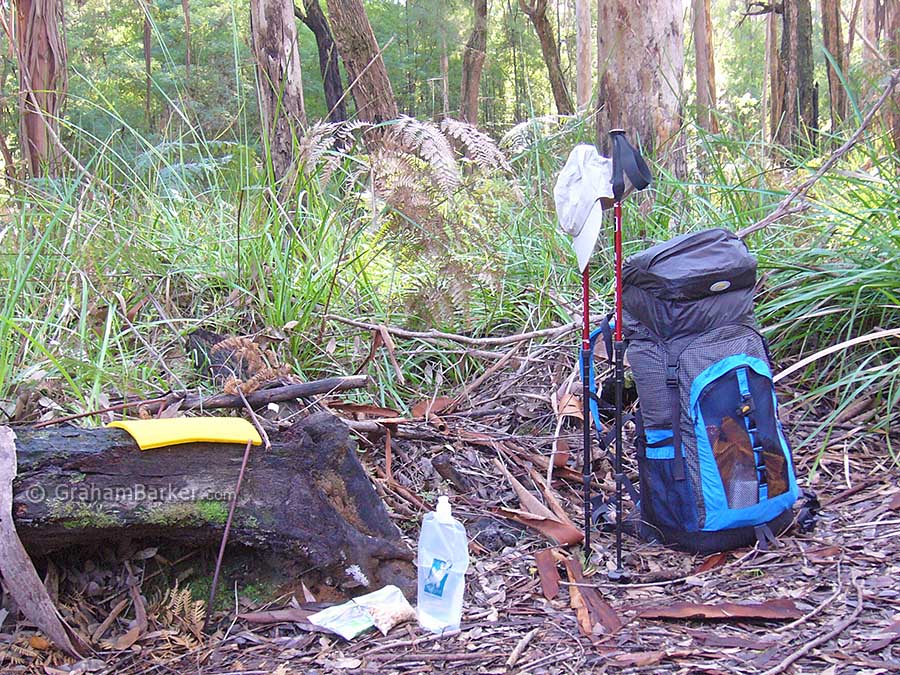
Any old log is a tea break opportunity
Lingering after a relaxed breakfast, soaking up the surroundings and listening to the birds singing, meant more to me than getting an early start and making good progress. Covering a lot of ground has rewards, and I'm not knocking those who focus on that. But I would rather thoroughly enjoy the scenery than just fly through it. Judging by the other comments in the log books, I’m far from alone.
Enjoying the journey really is more important than just getting to the end. I’ve found that to be the case for travelling in general, but it was my wanderings on the Bibbulmun Track that snapped it into focus. There is much to enjoy on Western Australia's Bibbulmun Track, even if you don’t get to walk all of it.